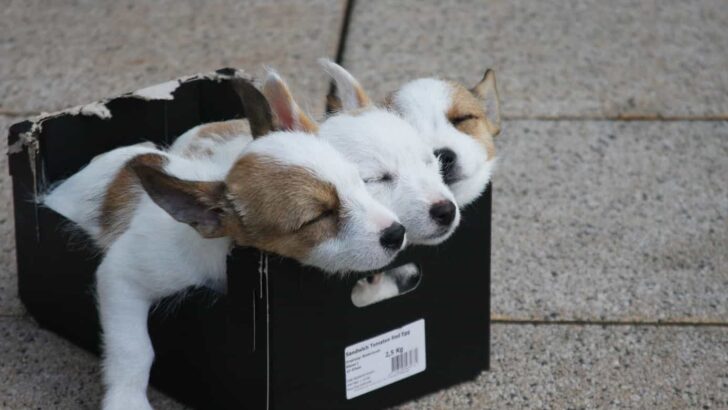- Nom Nom Dog Food Subscription Review - November 7, 2023
- 7 Best Dog Bed Ideas For Great Dane (DIY Options) - July 16, 2022
- Top 5 Rated Best Non-Prescription Diabetic Dog Food - July 15, 2022
I know that some of you shudder at the thought of being separated from your darling little puppy for more than the time it takes to sneak to the bathroom. As if they let us go to the bathroom by ourselves! In spite of your separation anxiety, it is a good idea to crate train dogs and I hope you’ll see the wisdom by the time we’re done.
This guide to crate training a puppy will take you step-by-step through the process. I’ve also added a few modifications for older dogs. The steps are generally the same, however, so most of the puppy advice will suffice for dogs of all ages.
Overall, we’ll cover:
- Crate training for puppies
- Crate training modifications for adolescent and adult dogs
- Why crate training is good for your dog
- Appropriate dog crate sizes, and
- Should dogs be crated at night?
Most experts believe that crating is natural, since dogs seek dens and secure spaces to sleep. While this is true, it doesn’t mean your puppy will immediately love her crate. Your job is to teach her that it’s a cool place to be.
Basic Crate Training for Puppies
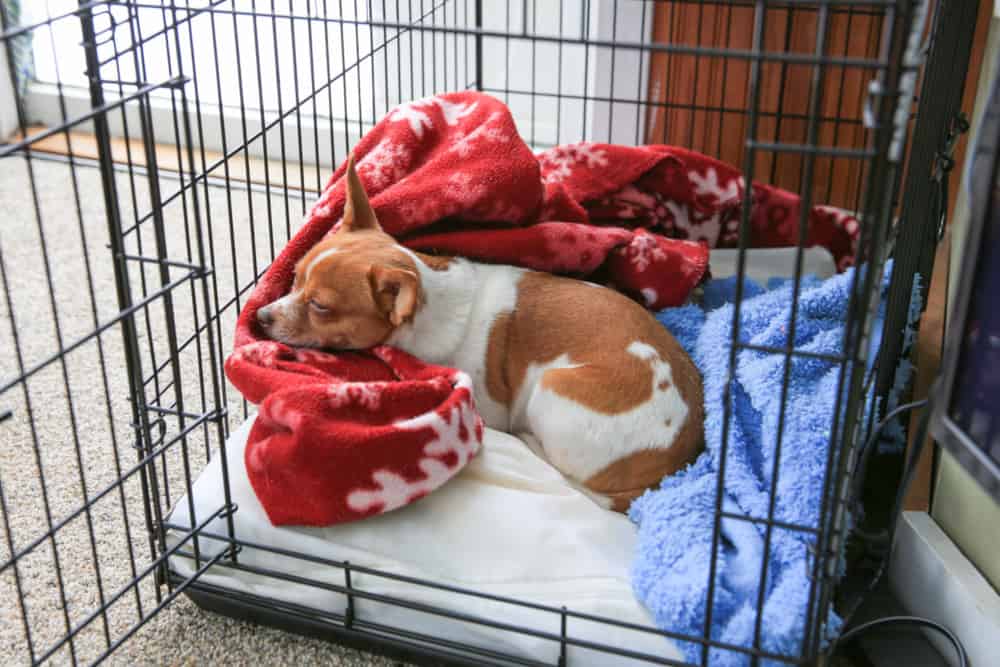
First, I want to cover a few facts.
Your puppy is brand new to the world and has little to no idea what you want from her. No matter how frustrating things get, be patient and kind. You can also be firm, but do try to make friends with your puppy over the first few days together.
It’s important to bond before you have the leverage needed to coax them into listening to you.
It’s essential that you or a family member have some time to spend with your new puppy. Take the week off of work. Ask a friend to spend the day with your puppy for the first week or two. Hire a pet sitter if you have to.
This may sound daunting, but your puppy needs direction and reassurance. She also needs to pee every 20 minutes or so, so being there really helps!
There is a difference between a traumatized puppy and a bratty one. Try to look for signals. Your puppy may start whining in the crate and if she does, you want to know when to be firm and when to be understanding.
According to the Humane Society, puppies six months old and younger should only be crated for 2-3 hours at a time. They have little bladders and bowels and need to go more frequently than older dogs.
Crate Training Step 1: Introduction
Puppy, meet crate. Crate, this is the puppy. You two will be fast friends.
Hopefully it will be fast, anyway!
When you begin crate training your puppy, think of the crate as a playhouse. It is not for punishment. It is not a prison. Do not scoop up the dog, plunk her in the crate, and walk away. All of this behavior can form a negative association with the crate and you don’t want that.
- Open the crate door and secure it so it doesn’t swing quickly or close on your dog.
- Lead your puppy to the crate and explain the situation in a happy voice. What you’re saying doesn’t matter so much, it’s your tone. Try to sound happy but not excited.
- Drop a few treats near and just inside the crate. Praise your puppy when she steps inside. You may need to progressively sprinkle kibble or treats further toward the back of the crate to coax your puppy all the way inside. Whatever you do- don’t force this. Stop and try again later if your puppy is frightened or unsure.
- Repeat this procedure every hour or so until your puppy is happily entering the crate to get the food or treats. You can also put a toy or two in the crate. See if your puppy lingers or plays in the crate. This is a great sign!
That’s it for step one. Don’t move on to step two until your puppy seems comfortable with this whole thing so far.
In fact, hang out on the floor near the crate yourself and do some reading or compulsive Facebook scrolling. Talk on the phone to friends. You guys are just two buddies hanging out with a rigid friend who’s kinda square… or rectangular.
Crate Training Step 2: A Lovely Crate For Dining
Now that your puppy goes freely into the crate, serve each meal inside. The goal is to get your puppy to go all the way to the back of the crate to eat. Once she’s regularly doing this, try closing the door until she’s done. Open it up again right away when she finishes.
This is also a progression. Leave the door closed a few minutes after your puppy’s all done noshing. Start with two minutes or so and work up to ten. Be sure you go slowly- you ideally want your puppy to go along with this without whining.
Dogs often like to eat when their people eat because of their pack based social structure. A little separation anxiety is also occasionally responsible for this behavior. I recommend that you have a small meal or snack near the crate the first few times you try Step 2. At the very least, this will model the behavior you want to your dog.
If your dog whines before you open the door, try to distract them with a sound or hand gesture so they stop whining before you let them out. You need to let the dog out right away, but want to do something to break the mental association between whining and getting let out.
Never yell at your puppy in the crate or hit or shake the crate, however. This is simply cruel. It’s also counterproductive because your puppy is more likely to grow afraid of the crate.
Crate Training Step 3: Longer Crating
By the time your puppy is eating comfortably in her crate, you can start the actual crate training.
- Call your puppy to the crate and provide a treat or piece of kibble.
- Pick a command that means enter the crate. The word ‘crate’ works just fine, but pick what you like. Give the command, and point inside the crate with a treat hidden in your hand.
- When she’s inside, tell her what a wonderful creature she is and drop the treat. Close the crate door.
- Quietly sit near the crate for at least five minutes. Next, get up and leave the room for another five minutes. Then, return to the crate, sit next to it for another five minutes. Finally, you can open the door.
- Repeat these steps a few times each day, slowly increasing the time intervals for each step. For instance, if your puppy is calm with five minute intervals of sitting, leaving, returning, and releasing, try extending that to six or seven minutes at a time. Go slowly with this, but you’re working up to a 30 minute exercise where you are mostly out of your dog’s line of sight while she is crated.
- When you let your dog out of the crate, take her outside immediately. This helps with potty training and also gives your dog something to look forward to when crate time is over.
- It could take days or weeks to get to a point where your puppy is comfortable in the crate alone for around 30 minutes at a time. Once you get there, you can leave your home for an hour or so while your puppy is crated.
Crate Training Step 4: You’re Outta There!
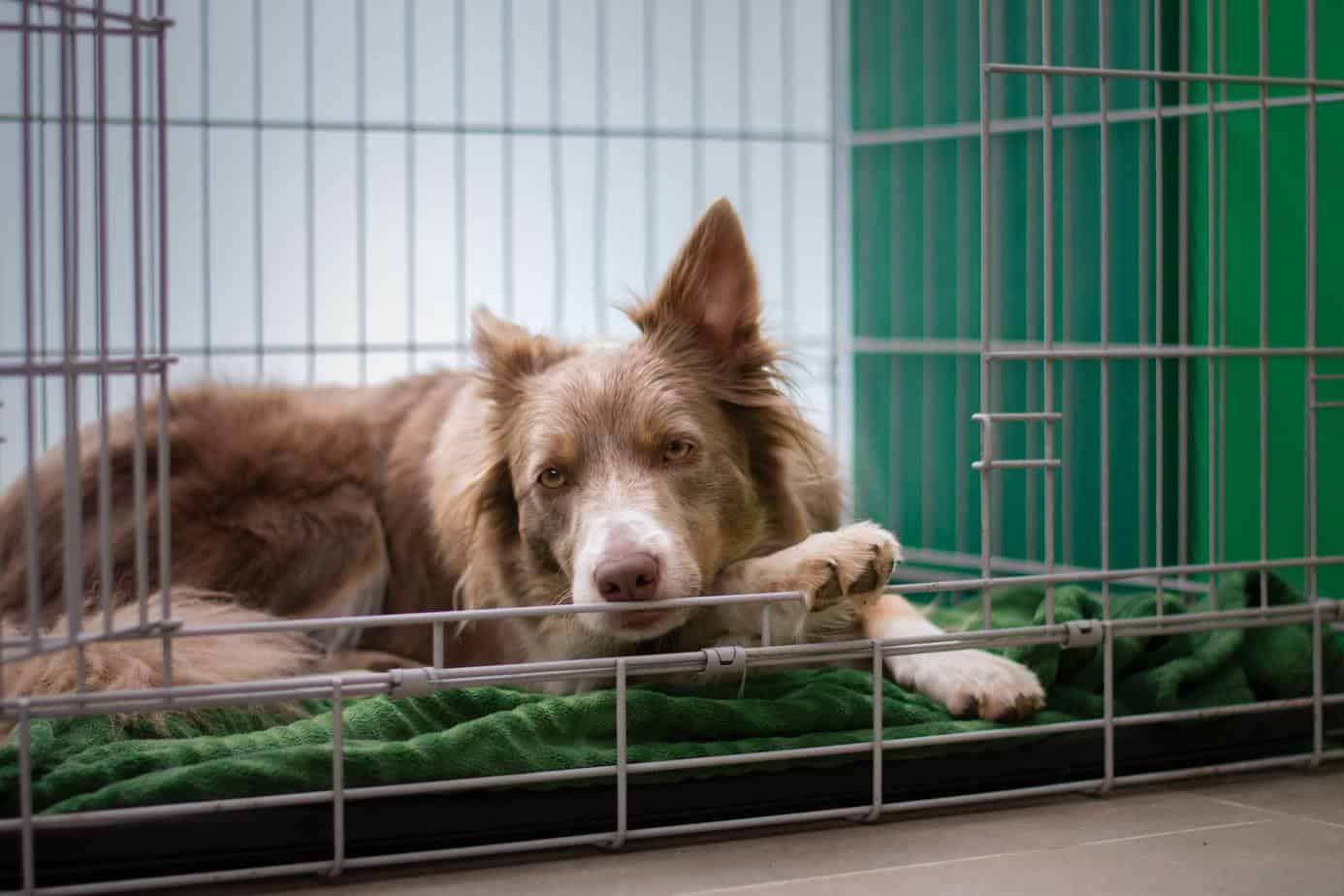
Now you’re ready to leave the house or try crating at night while you sleep.
- Crate your dog using the command and give her a treat. It’s fine to leave some toys in the crate so she can stay occupied while you’re away.
- Dogs pick up on our routines, so try to do different things before you leave. This will keep your dog from anticipating or dreading crate time. Conversely, however, if you think your dog is anxious about suddenly going into the crate, you can pick a word that means ‘crate time soon’ and use it 15 to 20 minutes before you give the crate command. Some dogs do like to know what is coming and others do better living totally in the moment. Either way, don’t leave your puppy in the crate longer than 20 minutes before you leave as this can promote anxiety.
- Be cool about all of this. Don’t give your puppy a sappy and emotional goodbye. This is just something that’s happening and it’s no big deal. You can eventually use phrases like “I’ll be right back” for short outings, or “I’m going to work now” when you’ll be away all day. Saying goodnight works well in the evening at bedtime. This helps some dogs manage their expectations.
When you reappear, either from an outing or in the morning, don’t act overly excited to see your dog. I know it’s hard, but this is the best way to manage your dog’s energy level.
It’s also a good idea to occasionally crate your puppy for up to 30 minutes while you’re home so she doesn’t associate the crate with your departure.
When To Stop Crate Training
You never really stop crate training unless you’re only crating your dog during potty training. Some people do let their dogs roam freely with no problems, however. This is up to you.
I do encourage you to keep up with at least occasional crating so your dog is used to the idea in case of an emergency or some unforeseen situation. If someone has to care for your dog and needs to put her in a crate, it will be easier on everyone if she’s used to the idea.
Crate Training Modification For Adolescent and Adult Dogs
The procedure for crate training older dogs is pretty much the same! You want to start and go slowly.
Limit initial crating to only 30 minutes or so just like you do for puppies. ,Even though adult dogs can wait longer to go to the bathroom, they’ll need some time to get used to what is expected of them.
Remember that older dogs or rescued dogs may have some dark times in their past. It is very important to tune in to your rehomed dog to try to pick up on anxieties left over from their last situation.
You may need to establish a positive association with the crate itself, so don’t rush the first step in this guide.
It really helps to exercise your adult dog before crate training. This will burn off some energy to help put them in a calmer state.
Is It Cruel To Crate A Dog?
For people, it feels a little cruel to be leaving your dog in a crate while at work. However, the truth is that crate training draws on dogs’ natural instinct to sleep in cozy, secluded spots.
The crate can serve as your dog’s den. It’s a space of their own where they can retreat for some quiet time.
There are two main factors in properly crate training your dog:
- Don’t use the crate as punishment; and
- Form a solid, positive association to the crate for your dog.
You can support this positive outcome by not reprimanding your dog with ‘time out’ in the crate. It’s also smart to give your dog some privacy when they enter their crate on their own.
Covering the crate with a fleece blanket, adding a soft dog bed, and including a few toys inside also fosters a proper relationship between your dog and the crate.
Another important thing to remember about crate training is that your dog should have free access to the open crate whenever you’re home, and not spend more time shut in than socializing with you and your family.
You can use the crate to head off anticipated problems. For instance, if your dog gets overexcited when company comes, crate her first. Calmly place the dog into the crate before the company arrives, and let the dog out when she settles down.
I don’t advise crating your dog for discipline, however. This may sound like a small distinction, but it’s extremely important that your dog not associate the crate with punishment.
How Big Should Your Dog’s Crate Be?
If you’re crate training a puppy, you want to choose a crate that will grow with the dog. This means that you can purchase a crate in a larger size to correspond with your puppy’s adult size and block off the rear of the crate with a divider until your dog grows into it. Many crates come with dividers for this very reason.
Another option is to rent a crate from your vet or a local shelter. Many facilities offer this kind of program for puppy owners.
Crates come in several different styles. There are plastic crates, often used for travel. There are also metal crates with panels (some of these expand to grow with your dog).
The Association For Professional Dog Trainers has a very handy crate size guide. I will reproduce their information here for you. I’m including a link for most sizes as an example.
| Crate Size | _________ | Dog’s Approximate Weight | |
| ___ | |||
| 18″x18″ or 18″x24″ | Up to 24 lbs Up to 30 lbs |
||
| ___ | |||
| 24″x18″ or 24″x24″ | Up to 30 lbs Up to 38 lbs |
||
| ___ | |||
| 24″x30″ or 24″x36″ | Up to 40 lbs Up to 40 lbs |
||
| ___ | |||
| 30″x24″ or 30″x30″ or 30″x36″ |
0-40 lbs 40-50 lbs 50-60 lbs |
||
| ___ | |||
| 36″x24″ or 36″x30″ or 36″x36″ |
40-60 lbs 50-60 lbs 60-80 lbs |
||
| ___ | |||
| 42″x30″ or 42″x36″ | 80-100 lbs 80-100 lbs |
||
| ___ | |||
| 48″x24″ or 48″x30″ | 80-90 lbs 80-100 lbs |
||
| ___ | |||
| 48″x36″ | Up to 100 lbs | ||
| ___ | |||
| 60″x36″ or 72″x36″ | 100-150 lbs 150-180 lbs |
Should I Crate My Dog At Night?
I’m sure a few of you are wondering, should I put my dog in a crate at night? You certainly can, and this helps a lot with puppies or older dogs with incontinence issues.
During the night, it’s best to keep the crate near you. Will it fit in your bedroom? Your puppy or older dog will be reassured by your nearby presence and you’ll be able to jump up for potty breaks during the night as needed.
As your dog gets used to being in the crate at night, you can move the crate to another area of the house if you need to. Just don’t rush this step.
How Long Should A Dog Be In A Crate?
Your dog should spend more time out of the crate than in it. That being said, she can probably spend 4-5 hours in the crate while you are away once she is old enough to regulate her bathroom habits.
WebMD offers this helpful chart for crate duration based on a dog’s age:
Dog’s Age
Duration of Time in Crate
8-10 weeks
30-60 minutes
11-14 weeks
1-3 hours
15-16 weeks
3-4 hours
17+ weeks
4-5 hours
You may need a pet sitter or friend to help you peek in on your puppy during the day if you work outside your home. She needs some time out of the crate to play and burn off energy. She also will obviously need to use the bathroom.
What Kind of Crate Should I Get?
For our purposes here, let’s break up the crate categories into 5 types. You can buy a wire dog crate, a plastic dog crate, soft-sided crates, heavy-duty crates, and cute or novelty crates. There is some overlap in these categories, but this gives us a place to start.
Wire Dog Crates
This is the style most people imagine when buying a dog crate. The bottoms are often plastic, but the sides and top are metal, large gauge wire. Some have only one door, and some have two or three.
Pros
- This style crate has plenty of ventilation so it’s good for dogs that overheat and hot climates.
- You can choose a model that comes with a divider to allow you to modify the size of the crate. This is very useful for puppies and can save money versus buying several crates of different sizes.
- You can collapse many wire dog crates for easy transport and storage.
- It’s easy to clean the bottom of the crate, as most have a plastic insert that pulls out of the frame.
Cons
- They’re louder, harder to handle, and will make noise as your dog moves around.
- Some dogs learn how to escape.
- Some escape-artist dogs find that it’s easier to break out of wire crates
- The sides aren’t solid, so there is potential for messes outside the crate.
- Some find them unattractive.
Wire crates that I recommend are:
MidWest iCrate Folding Metal Dog Crate
Plastic Dog Crates
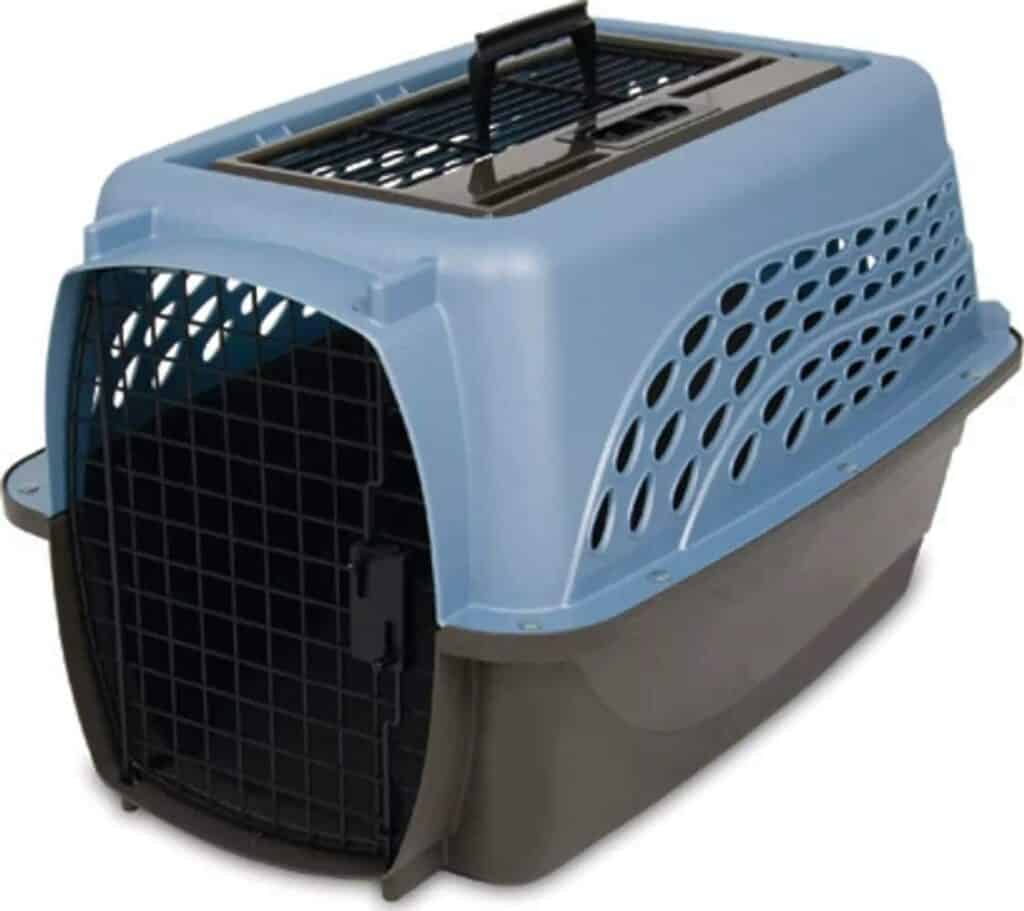
In smaller sizes, these crates are easier to move but that changes drastically in larger plastic crates. You’ll sometimes see these crates called hard sided dog crates.
Pros
- Your dog may feel safer in a more enclosed space.
- They travel well and are accepted by airlines. If you have to fly with your dog, he’ll already be used to the crate.
- They’re difficult to break out of.
- There are more variations in color available.
- Storage is so-so with plastic crates, but the top will stack in the bottom for some space saving.
Cons
- Less air circulation means a warmer interior. If your dog gets hot easily, this could be a problem.
- Some dogs like cozy spaces, but some like to see what’s going on around them. They’ll have less visibility in a plastic crate.
- They’re not as easy to clean as wire crates.
I think these plastic dog crates are a good value:
Soft-Sided Crates
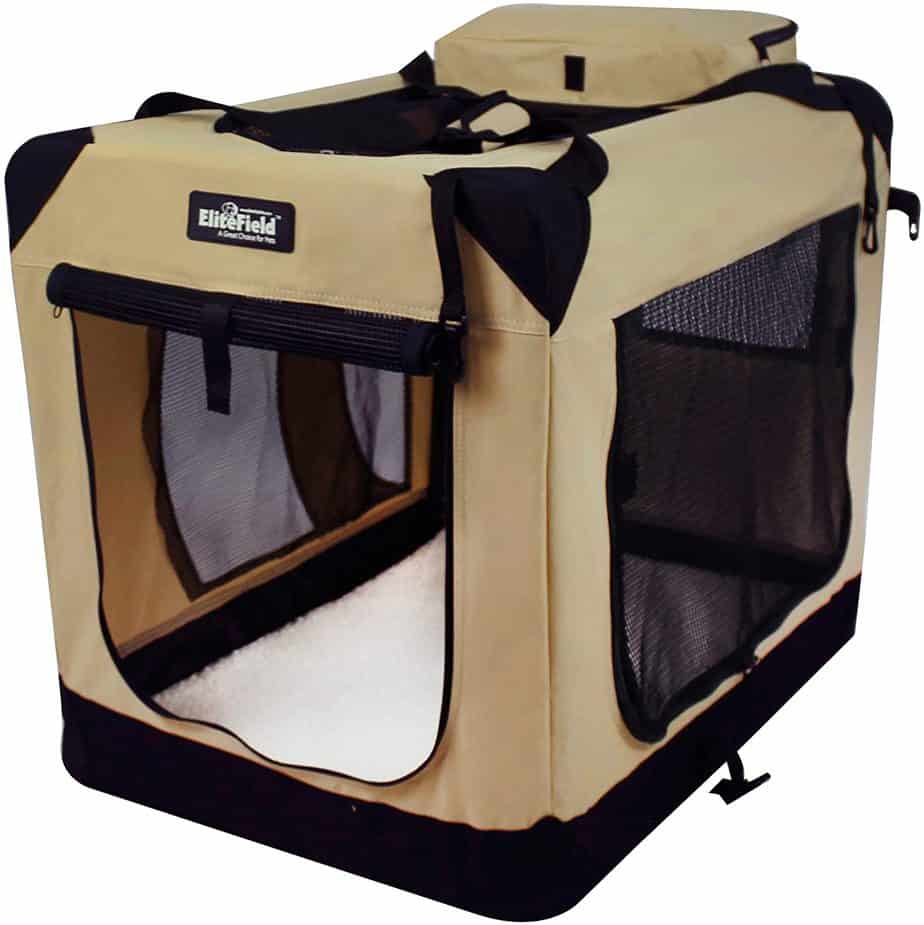
Soft-sided crates are an option for people with small dogs who don’t chew and destroy things.
Pros
- They’re the easiest to carry and move around because they’re very light-weight.
- They’re easy to transport and even use outside.
- These crates fold down to almost nothing for storage.
Cons
- They’re difficult to clean.
- A soft-sided crate isn’t very secure and won’t hold escape artist dogs.
- They may not take as much wear and tear as plastic or wire dog crates.
Some soft-sided crates I like are:
EliteField 3-Door Folding Soft Dog Crate, Indoor & Outdoor Pet Home
PetLuv “Tuf-Crate” Soft Sided Indoor / Outdoor Dog Crate & Carrier
Heavy-Duty Crates
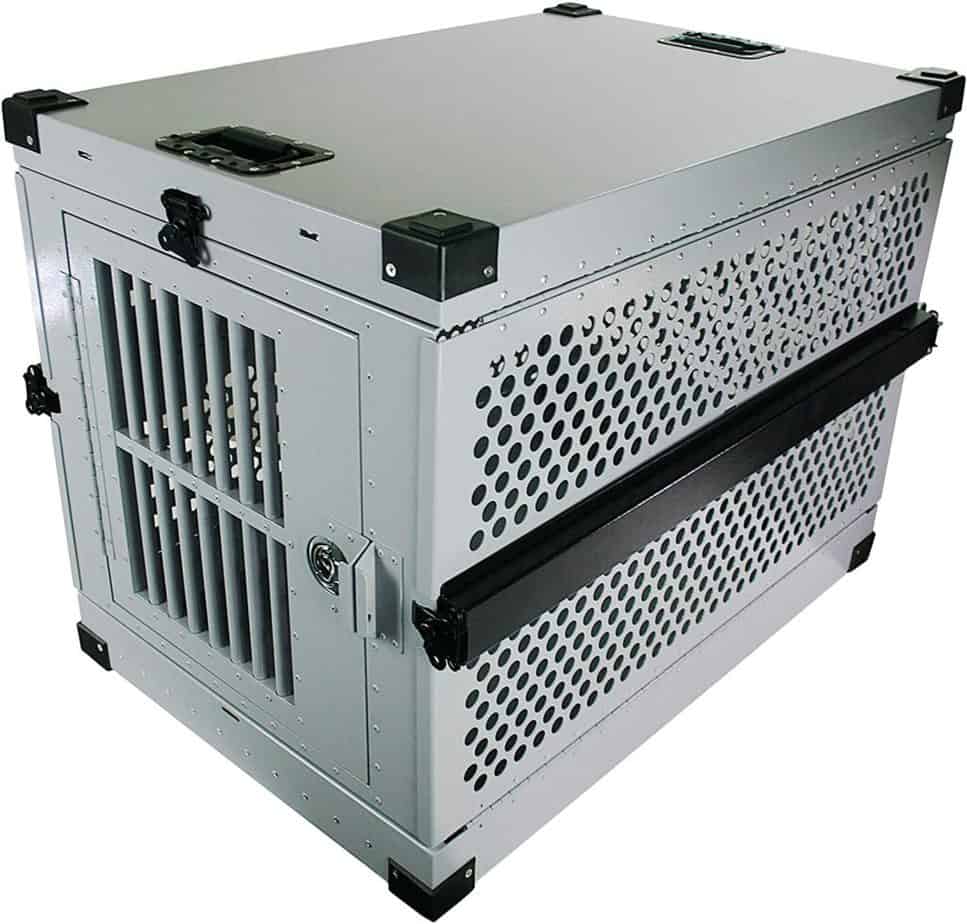
If your dog could break out of Alcatraz, consider a heavy-duty crate.
Pros
- There is almost no way your dog will get out of a heavy-duty crate. It’s like a doggie fortress.
- Some airlines approve certain models of heavy-duty crates which makes air travel less stressful for your dog.
Cons
- These crates cost much more than the other styles, but you probably won’t need to replace it.
- Some people think they’re unattractive, but I think they’re pretty impressive looking!
These heavy-duty dog crates are some of my top choices:
Cute Crates or Novelty Crates
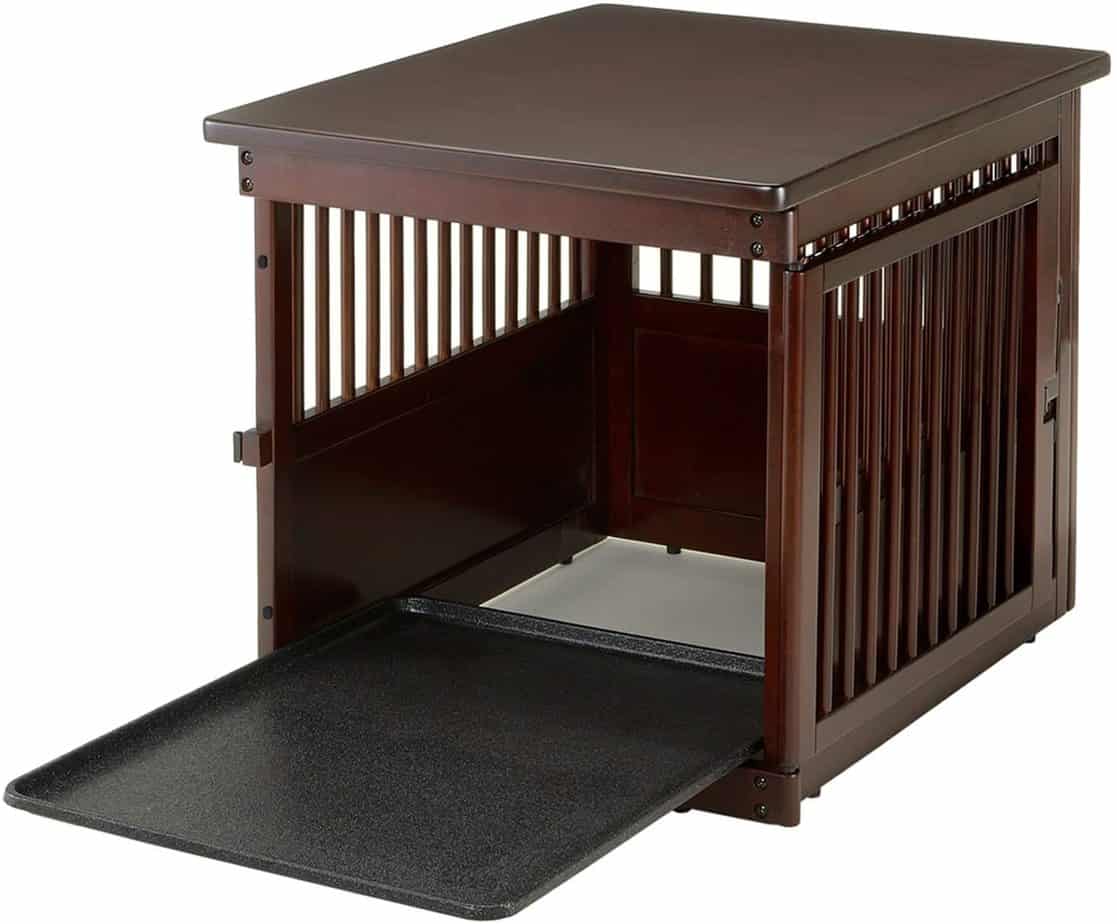
Finished wood, rattan, canvas, and other materials create some pretty unique crates to choose from. Are they a good idea?
Pros
- They’re adorable.
- Some can be worked into your decor or even serve as a table when not in use.
- Small breeds or nondestructive dogs are good candidates for this style of dog crate.
Cons
- Lots of dogs will chew right through wood, cloth, or rattan. The materials aren’t necessarily safe and could even contain toxic chemicals.
- Depending on the individual design, the crate could be ruined if your dog has an accident.
I’m not a fan of novelty crates because I think crates are a functional item that should be designed to do the job at hand. That being said, these are great looking:
ROYAL CRAFT WOOD Dog House Crate Indoor Kennel for Small Dogs
Are You Ready?
I’m sure this seems like a lot of steps to crate train your dog. Just take things slow and one at a time and you will progress through the steps with relative ease.
If you run into any difficulties during crate training, give your vet a call or speak with a dog trainer in your area. It is easier to do things right the first time than fix a problem once it is established. You can overcome stumbling blocks during crate training, however.
Here is a quick recap of crate training.
- Choose a crate that is the right size for your dog. See the guide above for help.
- Let your puppy or older dog get used to the crate before you close the door.
- Spend time conditioning your dog to enjoy the crate by giving food and treats inside, working toward closing the door while your dog is in the crate and eating.
- Slowly increase the amount of time the door is shut and your dog is inside.
- Never punish your dog with ‘time out’ in the crate.
- Do add comfy bedding and toys, as long as your dog doesn’t destroy them.
- Don’t leave puppies unattended in the crate for longer than two hours at a time. Adult dogs shouldn’t be left for more than 4-5 hours.
- Put the crate in your bedroom at least in the beginning of training if you plan to crate your dog at night.
- Praise your dog, but make going into and coming out of the crate a calm experience.
Do you have any crate training tips to share? Let me know in the comments section.
Good luck and be patient!
Continue reading:
How To Crate Train A Dog- From Puppies To Old Timers

